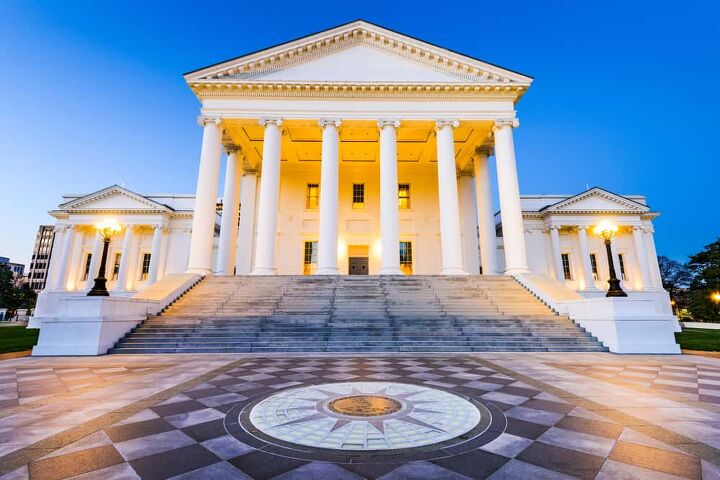10 Cheapest Places To Live In Virginia

Virginia is known as the “mother of presidents”, but it is just as notably known as a cheap place to live. Home to 95 counties and 38 cities, Virginia has no shortage of places to live, and many of them are inexpensive. With so many affordable options to choose from, what are the cheapest places to live in Virginia?
The cheapest place to live in Virginia is Danville, with a cost of living 29% less than the national average. Danville’s overall housing costs are 70% less than the US average, with a median home value of $71,400, and rent for a 3-bedroom $997. Other cheap places to live in Virginia are Martinsville, Covington, Richlands, Pulaski, Galax, Bristol, Big Stone Gap, Marion, and Vinton.
Do You Need to Hire Movers?
Get free, zero-commitment quotes from pro contractors near you.

10 Cheapest Places To Live In Virginia
A combination of low housing, utilities, rent, and gasoline prices all contribute to a town’s affordability. Let’s take a look at each of the cheapest places to live in Virginia and what makes them so affordable.
1. Danville Tops List Of Cheapest Places To Live In Virginia
- Median Home Value: $71,400
- Monthly Rent Cost for a 3-bedroom: $997
- Average Monthly Utilities Cost: $100-$190
- Population: 39,869
- Median Household Income: $32,173
The median value of homes in Danville, Virginia is below the national average and totals $71,400. Expect to pay roughly $994 each month, including mortgage, in total homeownership costs. Low utility costs that don’t often exceed $190 keep monthly ownership and rental costs low.
Apartment costs vary based on your location relative to the center of Danville. Rental prices range between $440 and $1,000 in Danville, and the cheapest option is a one-bedroom outside of the central city. Your priciest apartment options in Danville, VA are 2-3 bedrooms, and they cost between $800 and $1,000.
Single residents of Danville, VA average $20,569, and that is $7,986 below the national average. Household income is higher, however, and averages $32,173 each year in Danville, VA, and that is enough for comfortable living.
2. Pulaski
- Median Home Value: $121,800
- Average Monthly Rent Cost for a 3-bedroom: $886
- Average Monthly Utilities Cost: $130
- Population: 8,657
- Median Household Income: $36,057
The low cost of living in Pulaski keeps the 9,540 firmly planted in this southern city. Not only are rent costs low and average $545 a month, but utilities only cost $100-$130. The only living expense that is somewhat high in Pulaski is gas, which at $2.44 a gallon totals $1,600 yearly.
Pulaski is one of the cheapest places to live in Virginia, and single residents average roughly $20,189 a year. Households bring in more income and average $36,057 per year, which is enough to be a homeowner in Pulaski.
Total monthly homeowning costs in Pulaski come out to just over $1,000, and that includes mortgage payments. Roughly $350-$400 of that cost comes from bills, repairs, and maintenance. Currently, 72.3% of residents are homeowners, and that is due to the $121,800 median home value.
3. Covington
- Median Home Value: $81,900
- Average Monthly Rent Cost for a 3-bedroom: $1,017
- Average Monthly Utilities Cost: $100-$140
- Population: 5,639
- Median Household Income: $38,176
One of many cities named Covington in the south, Covington, Virginia is a highly affordable city. Currently, 59.2% of Covington residents own their homes, and the median home value is $81,900. Not only are homes cheap in Covington, but property taxes are as well, and average $424 a year.
Only 20.3% of residents are renters in Covington, and the monthly average is $518. For between $500 and $900, you can find a one-bedroom apartment in Covington. Three bedrooms earn you more space, but they can also cost as much as $1,500 a month, averaging $1,017.
While Covington is quite cheap, gasoline is slightly more expensive than other places in Virginia. You can expect to pay between $3.08 and $3.10 per gallon at the pump in Covington. Covington is a car town, and there are many commuters, so that can add up to $2,020 or more per year.
4. Vinton
- Median Home Value: $197,400
- Average Monthly Rent Cost for a 3-bedroom: $1,090
- Average Monthly Utilities Cost: $80-$170
- Population: 8,096
- Median Household Income: $43,623
You can buy homes in Vinton, Virginia for a bargain, and that’s why 51.8% of the city’s residents own homes. With the $43,623 average income, roughly 15.65% or more of your income in Vinton goes towards mortgage payments, on average.
Studio apartments are the cheapest option in Vinton, Virginia, and you can pay as little as $550-$700 per month. Otherwise, your monthly rental costs will likely be on par with the $875 average throughout Vinton. Utility costs vary widely based on energy usage, but they generally range between $80 and $170 in Vinton.
Expect to pay about $0.93 for every $100 in assessed home value for annual property taxes in Vinton, VA. Real estate costs also include a tax of $0.07 for every $100 dollars in home value. Vinton is an excellent Virginia city with a low cost of living, and a reputation for extraordinary public education.
5. Marion Is One Of Cheapest Places To Live In Virgnia
- Median Home Value: $103,400
- Average Monthly Rent Cost for a 3-bedroom: $895
- Average Monthly Utilities Cost: $70
- Population: 5,555
- Median Household Income: $29,900
Marion, Virginia is made up almost equally of both homeowners and renters. The homeownership rate is 45.1%, and that leaves plenty of room for renters. The low rent paired with the low average single-resident income of $21,618 is why there are fewer homeowners than in other cities.
Homes are quite cheap in Marion, and they are far below the $291,700 national median home value. Marion residents pay a median of $103,400 for homes in their city, and it comes with roughly $863 in monthly costs. In the last year, there has been a 6.1% increase in home value, which is far below the national average.
Rent is somewhat high for such a cheap city, but the roughly $70-$100 in utility costs are low. You can pay between $800 and $1,200 or more for an apartment or house rental, but the average is $850. Besides basic utilities, there are extra costs, such as $40-$50 for internet bills, and $50-$100 for cable plans.
6. Richlands
- Median Home Value: $75,300
- Average Monthly Rent Cost for a 3-bedroom: $799
- Average Monthly Utilities Cost: $147
- Population: 5,224
- Median Household Income: $34,781
It may have the word “rich” in its name, but you don’t need wealth to live in Richlands, since it’s also one of the cheapest places to live in Virginia. The median household income in Richlands is $34,781, and that is enough to live comfortably. There is a $53,482 national median income in America, but Richlands residents generally make enough to keep up with the area’s low cost of living.
Median home values are far below the Virginia average and the United States average as well. The median home value for a home in Virginia is $329,200, and that is $253,900 more than the Richlands average. Rent costs are also quite low, and $527 plus $147 in utilities cost can get you an apartment in Richlands.
The vast majority of Richlands, Virginia residents are homeowners. Only 29.1% of the population of Richlands are renters. You will spend approximately $957 each month on homeownership costs in Richlands, so renting is a better option for some residents.
7. Big Stone Gap One Of The Cheapest Places To Live In Virginia
- Median Home Value: $115,300
- Average Monthly Rent Cost for a 3-bedroom: $962
- Average Monthly Utilities Cost: $70-$170
- Population: 5,104
- Median Household Income: $37,165
Currently, 45.3% of all Big Stone Gap residents are homeowners, and with such low housing costs, it makes sense. If you add up the monthly costs of owning a home with Big Stone Gap mortgage rates, it rarely exceeds $1,100. Even though housing costs are so low in Big Stone Gap, almost 40% of the population are renters.
When you see that rent ranges between $450 and $1,000 a month in Big Stone Gap, it explains the volume of renters. Even if you factor in between $70 and $170 in utilities, rent can cost $520-$620 per month in Big Stone Gap. Budget yourself another $50 or more a month for cable, and $40 or more for internet costs as well.
The low cost of living in Big Stone Gap is quite low, but so is the average income. Single Big Stone Gap residents average $14,147 per year in income, and the median income for households is $37,165. Both numbers are below the national medians, which are $28,555 and $53,482, respectively.
8. Galax
- Median Home Value: $120,700
- Average Monthly Rent Cost for a 3-bedroom: $987
- Average Monthly Utilities Cost: $70-$170
- Population: 6,296
- Median Household Income: $30,430
Compared to other cities on this list, Galax’s population is made up overwhelmingly of homeowners. Currently, 54.5% of Galax residents own homes, and the median age of homeowners in town is 41 years old. You can blame the $120,700 median home for the high homeownership rate in Galax, and there are unbeatable prices.
Apart rental costs vary largely in Galax and one-bedrooms average $591 per month. Two-bedroom apartments rarely cost more than $730 per month, and three bedrooms can cost as much as $1,300.
Household incomes are relatively low in Galax, but the low cost of living makes up for it. Your average household brings in $30,430 yearly in Galax, and that is enough to pay bills and buy groceries. Comfortable wages may need to be higher, but you can feasibly live with that yearly income in Galax, Virginia.
9. Bristol
- Median Home Value: $125,600
- Average Monthly Rent Cost for a 3-bedroom: $949
- Average Monthly Utilities Cost: $175
- Population: 16,482
- Median Household Income: $33,616
Apartment rentals average $720 a month, but it all depends on floor plans. For instance, you can find apartment leases for as low as $385 per month for studios in Bristol. A three-bedroom in Bristol, on the other hand, costs up to $1,100 each month.
Family households in Bristol, VA earn more money than single residents and bring in $33,616 per year. That is less than half of the $74,222 median household income in Virginia, but it is livable in Bristol.
With a combined sales tax rate that totals 5.3%, trips to the store won’t rob you blind. Sales tax can cost up to 7% in Virginia, so Bristol residents are lucky to get away with less. Utilities can get pricey in Bristol but doing anything you can to conserve energy can keep those bills low.
10. Martinsville
- Median Home Value: $77,300
- Average Monthly Rent Cost for a 3-bedroom: $945
- Average Monthly Utilities Cost: $100-$250
- Population: 12,355
- Median Household Income: $27,746
Martinsville, Virginia rounds out our list of the cheapest places to live in Virginia. It is one of the bigger cities on this list, and 43.8% of its 12,355 residents own homes.
Not only are homes cheap and have a $77,300 median value, but monthly ownership costs are low as well. Before mortgage payments, you’ll spend close to $350 in ownership costs, plus another $550 for the mortgage.
Rent costs average $650, but you can find small one-bedrooms in Martinsville for about $450 a month. Smaller apartments with few appliances can only rack up $100 in utilities. Otherwise, you may spend as much as $250 for large apartments with many plumbing appliances and high energy use.
Gas can cost as little as $2.88 per gallon in Martinsville, and that equals $1,889 in yearly gas costs. Public transportation is not a readily available alternative in Martinsville, but with low gas costs, driving is worth it. Even dining is cheap in Martinsville, and fancy, three-course meals rarely exceed $40-$50, and that includes drinks.
Lowest Property Taxes In Virginia
When you’re a homeowner, property taxes often figure heavily into determining the cheapest places to live in Virginia. The state average property tax rate in Virginia is 0.74%, and the national average is 1.07%. There is one county in Virginia in particular that has the lowest property tax rate, and that is Buchanan County. Expect to pay an annual property tax rate of 0.46%, and that averages roughly $284 each year.
Compared to the average $1,862 per year throughout the state, Buchanan County residents save a small fortune. Other counties, such as Dickenson County, also have low rates, and residents spend an average of $368 per year. There is a widespread savings in annual property tax costs throughout Virginia, and it goes hand in hand with home values.
| Virginia Counties | Annual Property Taxes |
| Buchanan County | $248 |
| Dickenson County | $368 |
| Caroline County | $1,099 |
| Essex County | $852 |
| Accomack County | $650 |
The highest property tax rate in Virginia is Falls Church, and it carries a rate of 0.94%. Residents of Falls Church pay an average of $6,729 every year in property taxes. That is due to the high median home value in Falls Church, which comes out to $697,800.
Cheapest Car Insurance In Virginia
The cheapest car insurance in Virginia is in Galax, and annual car insurance premiums range between $761 and $945. Erie offers the most affordable auto insurance, and if you have a clean driving history, it can cost as little as $687 a year. Depending on driving history and the particular city, Geico is often the highest premium and averages $1,029 a year.
Virginia residents spend $901 every year in car insurance costs, on average. Nationally, Americans pay as much as $1,427 more annually on car insurance. Car insurance rates in Virginia vary based on age, driving history, and the number of drivers in your area.
Just like anywhere else, there are high yearly premiums on car insurance for new drivers in Virginia. Brand new drivers carry yearly car insurance premiums up to $4,185, and it incrementally increases to $2,266 by 19. The lowest cost for annual premiums in Virginia comes for residents in their 60s, and it averages $766.
Cheapest Gas In Virginia
Gas costs can throw a monkey wrench into your budget, but not in Virginia. The whole state has fairly cheap gas prices, and it averages $3.12 per gallon. If you are fortunate enough to live in Danville, however, you’ll pay some of the lowest prices in the state.
You can find gas prices as low as $2.72 per gallon in Danville, Virginia. If you drive as often as the national average of 656 gallons per year, you’d spend $1,784 every year on gas. Other counties closer to the Virginia average price could easily spend $2,046 or more on gas yearly.
Summing It Up
The cheapest place to live in Virginia is Danville, but Pulaski and Covington are not far behind. You can get by on wages of $13.39 an hour, or $20.12 if you have children in Virginia. Car insurance is quite cheap in Virginia, but it doesn’t get cheaper than Galax, where your premiums can be as low as $761 per year.
Cities like Danville are livable on low wages, and the average income is $20,569 for single residents. It doesn’t hurt that rent can cost as little as $440 per month in Danville. If you want to save on property taxes, move to Buchanan County where you pay $248 yearly.
Whether it be Galax, Martinsville, Danville, Pulaski, or Covington, you can get by at a low cost of living. Low gas prices, car insurance premiums, mortgage payments, and rent prices make these Virginia cities a great place to live.
Related Questions
What is the safest city in Virginia?
The safest city in Virginia is Broadway. Violent crime only affects 1 out of every 3,941 Broadway, VA residents. Property crime is slightly more come, and it impacts 1 in 438 people in Broadway.
What is the most expensive place to live in Virginia?
Fairfax County is the most expensive place where you can live in Virginia. You must earn just under $5,000 each month in order to comfortably live and pay bills in Fairfax County. The average monthly rent costs $1,942 in Fairfax County, and the median home value is $603,221.
Do You Need to Hire Movers?
Get free, zero-commitment quotes from pro contractors near you.


Nick Durante is a professional writer with a primary focus on home improvement. When he is not writing about home improvement or taking on projects around the house, he likes to read and create art. He is always looking towards the newest trends in home improvement.
More by Nick Durante



























